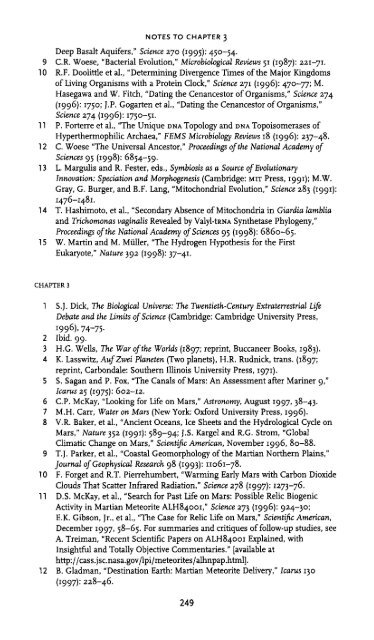You also want an ePaper? Increase the reach of your titles
YUMPU automatically turns print PDFs into web optimized ePapers that Google loves.
THE PLANET FINDERS<br />
fronts) of the light reaching them. Thus, it is necessary to measure the<br />
length of the paths taken by the starlight entering the two telescopes,<br />
with a level of precision down in the billionths of a meter.<br />
To explore and develop the techniques of optical interferometry,<br />
NASA has constructed the Palomar Testbed Interferometer (PTI) (see<br />
Color Plate 6). 13 PTI is run by a large group of JPL scientists, headed by<br />
Mike Shao; but when, sometime after midnight, we climb down from<br />
the catwalk of the Hale telescope and tap on the door of the PTI'S<br />
"beam-combining building," we are greeted by a lowly Caltech undergraduate,<br />
<strong>Be</strong>n Lane. Though he appears altogether too young to be entrusted<br />
with such an expensive piece of hardware, <strong>Be</strong>n is intimately familiar<br />
with all its mysteries, because he helped assemble and test it.<br />
He is soon snowing us with an avalanche of techno-speak—<br />
"dichroics," "delay lines," "tilt tables," "heterodyne lasers," "singlemode<br />
fibers," "fringe trackers," and so forth. Luckily one of us<br />
(Koerner) uses interferometry (at radio wavelengths) in his own research,<br />
so at least the principle of the thing is clear.<br />
Basically, two telescopes (the "north" and "south" telescopes, on<br />
this particular night) look at the same small region of sky, which is<br />
chosen to contain at least two stars: the star of interest and a nearby<br />
bright reference star. The reference star is taken as a fixed landmark;<br />
the star of interest, on the other hand, will be changing its position<br />
slightly from night to night, if it possesses planets. Thus, the aim is to<br />
determine as precisely as possible the position of the star of interest<br />
with respect to the reference star. (The reference star may have some<br />
"wobble" of its own, of course. Therefore, in practice it's necessary to<br />
use more than one reference star, in order to determine which motions<br />
are intrinsic to the star of interest.)<br />
<strong>Be</strong>cause the reference star and the star of interest are at slightly<br />
different positions in the sky, the wave fronts of the light coming from<br />
them approach the telescopes at slightly different angles. For example,<br />
if the peaks of the waves from the reference star happen to strike the<br />
two telescopes synchronously (in phase), then the wave fronts from<br />
the star of interest will strike the two telescopes slightly out of phase—<br />
the peaks may reach one telescope at the same time as the slopes or<br />
the troughs of the waves reach the other telescope. The interferometer<br />
has to measure the phase difference between waves from the two<br />
stars: this is a measure of the angular separation between them, as<br />
measured along the axis running through the two telescopes.<br />
To accomplish this, beam splitters inside each of the telescopes sep-<br />
125













